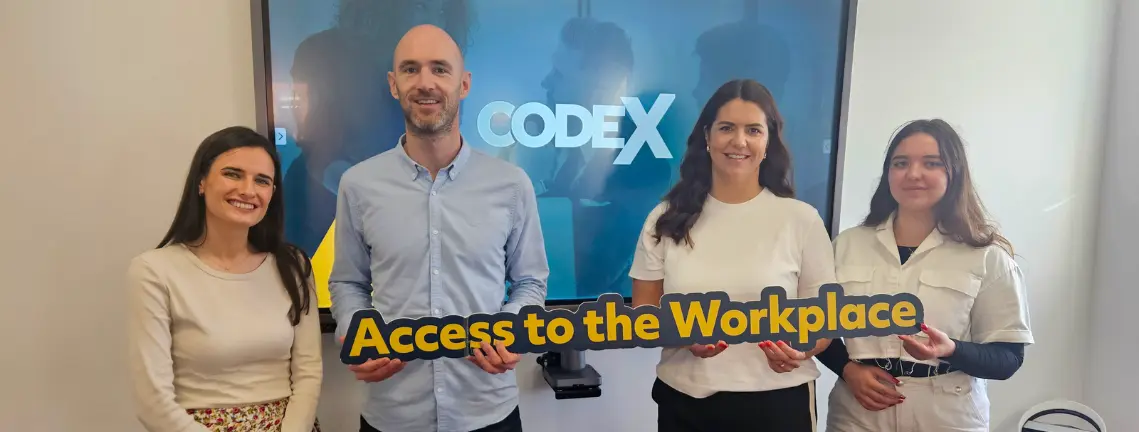Harnessing Hybrid Working with 4 Key Employee Personas


Events beyond our control have forced us to change how we work, collaborate, and learn. While many found the quick transition to remote work challenging, flexible work environments have also created new opportunities for others to succeed.
While each business leader has a slightly different vision of the post-pandemic workplace and how to navigate through the challenges and opportunities faced, the majority of the Irish workforce is choosing to opt for the flexibility of hybrid working over returning to the office full-time with a pay rise, according to the latest research.
To support the new hybrid workplace, however, it is crucial to understand that more than merely installing new technology is required. Organisations must adopt an inclusive perspective on collaboration and establish it as a principle of organisational culture. One way to do this is by determining and understanding your employee personas.
Every employee persona has value in the workplace and should be supported as organisations build their hybrid work culture. Organisations may quickly determine how their employees will be distributed and develop a strategic plan for the hybrid office using a persona-based approach. Below, we discuss four types of employee personas and where to get started in determining what personas exist in your organisation.
Office Soloists
Soloists have embraced hybrid working. Soloist employees are self-sufficient and flourish when left alone with little assistance. They like the freedom of remote employment. They are okay with attending the office for meetings when necessary but prefer to work remotely whenever possible.
The typical open office layouts, with plenty of conference rooms and casual gathering areas where colleagues can congregate, may not be the best work environment for soloists. Instead, they could feel more at ease in their home office, where they can communicate digitally with their colleagues while having the necessary room for autonomous work and where a face-to-face connection is neither required nor necessary for their roles.
However, organisations must figure out how to keep soloists involved in the workplace culture while preventing them from isolating themselves too much. Inclusive hybrid meetings will ensure that people never feel excluded, and constant communication is essential.
Soloist employees can contribute to virtual group meetings by using modern collaboration tools to facilitate remote work instead of speaking out and becoming the loudest person in the room, which they often try to avoid. Employees previously reluctant to speak up during a physical brainstorming session may find sharing and conveying ideas much more straightforward when working remotely. As such, soloists will benefit from hybrid working, as it balances on-site and remote work opportunities.

Office Adapters
As implied, Adapters are the most flexible employees. They enjoy focusing just as much at home or in a coffee shop as they do when they enter the office. They anticipate a relaxed, dynamic working atmosphere that adapts to their requirements. When they are at work, they will need a place to concentrate and work quietly, such as acoustic office pods and meeting and collaboration areas. They search for the best conference room, peaceful co-working place, or energetic office social area because they do not have a specific preferred habitat. They do not have a fixed working mode like the Soloist. Adapter employees are willing to change if it results in more productive work.
Thanks to technology like easy and user-friendly space booking software, adapters can seamlessly transition between their homes and workplaces, always knowing when to come in and where to sit without bother or stress.
They will be content working remotely in a hybrid workplace environment. Still, they will want to visit the office to take advantage of the benefits of in-person collaboration and networking with employees. Organisations can keep their adapter employees happy by easing the transition between their various work modes, from offering an intuitive way to reserve desks and meeting spaces to data-driven workplace layouts.

Office Culturalists
On the opposite end of the spectrum, Culturalists might have disliked how working remotely denied them the chance to interact and collaborate with colleagues in an office setting. Culturalists appreciate the social aspect of going to work more than most people since they thrive on interpersonal relationships. When they are not in the office, they miss running into colleagues in the hallway, working face-to-face with people, and the general energy of the workplace. Being stranded at home working at the kitchen table will have been particularly unpleasant for culturalist employees.
As a result, culturalists prefer to work from home occasionally, happily choosing to attend work more frequently. And organisations must ensure their offsite experience is as collaborative and productive as their onsite experience.
Simple-to-use technologies that let them know when and where their colleagues are working and collaboration locations that are simple to reserve will keep culturalist employees involved when working from home. Yet, as we all know, meeting over tools like Google Meet, Microsoft Teams, and Zoom feels different and less personal. Therefore, culturalists seek intelligently designed, biophilic-inspired collaboration and socialisation spaces and breakout areas when working onsite to thrive fully.
All-in-all, hybrid work is a welcome approach for these highly involved employees to get the best of both worlds.

Office Traditionalists
Preferring to conduct business face-to-face, Traditionalists favour the office. If given a choice, they would go to the office daily and wish for conditions to resemble those before the pandemic. Some could find the idea of hot desking unsettling because they prefer to have their own designated desk. The flexibility of remote working does not appeal to traditionalists because they like the structure that working onsite provides them.
Understandably, this desire for privacy can be challenging in offices that have moved away from typical office space. Organisations with traditionalist employees must find a method to blend the stability of an office-first workplace with the dynamic nature of hybrid working. Setting aside some specific space for your traditionalist employees or implementing a straightforward, flexible approach that allows employees to reserve regular desk space will help to achieve this.
Better still, dedicated spaces like suspended offices are designed for employees who value and require both privacy and collaboration might be the right balance for traditionalist employees, as it honours their desire for personal interaction while offering a quiet space for focused work.
Finding a means for them to have a permanent desk – or at least book one long-term – and enabling them to sync their working patterns with colleagues will go a long way to recreating that traditional office atmosphere.

How To Get Started with Employee Personas
Instead of guessing employee personas, create profiles using qualitative and quantitative data. However, it is essential to remember that the above employee personas are general and will only catch some distinctive qualities.
1. Decide on a Strategy
Research employee personas from different organisations to better understand the idea and identify the traits you want to add to your own. Check your existing data, such as employee demographics and company survey results, to see what you already have and do not have.
Contact employees who have created personas before, as they may assist with formulating questions to gather the required feedback and might suggest formats.
2. Get Employee Feedback
Employee focus groups could be a fantastic way to gather the lacking information. Start a discussion and have them build on one other's thoughts, drives, and experiences.
Other potential research techniques include employee surveys, workplace observations, and one-on-one interviews. All this information will aid in the development of a clear grasp of what motivates and what demotivates your workforce.
3. Observe Patterns
Find suitable cohorts with similar pain points, behaviours, preferences for communication, etc. You can accomplish this by running the data via a robust analytics platform or conducting your data analysis if you have the time. Afterwards, each cohort should receive a name and pertinent details.
Remember to limit yourself to a few profiles. Turning your efforts into workable employee experience strategies will be challenging if you use too many personas.
4. Reiterate your Personas
You will likely need to tweak your employee personas as you continue to learn about your workforce. Hence, verify them with the employees they represent before using them. You can arrange another round of focus group discussions to do this. Once complete, the versions can be crafted into highly polished profiles.
Employee personas help make work experiences more valuable and profound, especially if you incorporate employee journey mapping. Employee journey mapping lets you pinpoint the moments that matter most to employees by dissecting the complete employee journey into discrete moments. With personas, you may have a more substantial impact in those settings. This is an excellent prospect given that people are working in new environments and businesses are dealing with unheard-of change.

Hybrid Working in a New Era
Being a Great Place to Work no longer means that place must be the office. More organisations are including hybrid working in their long-term strategies. In fact, twice as many organisations as last year, according to CIPD. But for many business leaders, maintaining productive working connections between colleagues that do not frequently interact in person is a new issue.
Organisations need to find time for colleagues to connect in person when possible to make hybrid working more effective and improve relationships at work. With loneliness and a lack of connection being two of the more negative aspects of the pandemic, finding the right mix of in-person and remote work will be important.
Hence, it is crucial for businesses to define and evaluate flexible and hybrid options that should be integrated into their company culture, which will also impact employee engagement and retention.
Defining your employee personas will help to personalise workplace experiences, get to know your employees inside out and identify the actions that will have the most significant impact on engagement, productivity, retention and, of course, deliver maximum organisational impact.
---
Are you looking to make your office workspace more collaborative and productive? We suggest you check out our range of Acoustic Pods and Breakout Areas. These self-contained spaces are designed to encourage employees to work and brainstorm together away from their desks, free from any distractions and noise.
Simply open a Codex account today or contact us at sales@codexltd.com if you require product recommendations or pricing!
RELATED ARTICLES:




